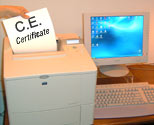|
| |

Healthcare Training Institute
- Quality Education since 1979
CE for Psychologist,
Social Worker, Counselor, & MFT!!

Excerpt of Bibliography referenced in
- Alderman,T. (1997). The scarred soul: Understanding and ending self-inflicted violence. Oakland,CA: New Harbinger Publications, Inc.
- American Self-Harm Information Clearinghouse. (2005). Mission. Retrieved June 23, 2008 at www.selfinjury.org.
- Ayton,A., Rasool, H., & Cottrell,D. (2003). Deliberate self-harm in children and adolescents:Association with social deprivation. European Child & Adolescent Psychiatry, 12(6), 303–307.
- Cerdorian, K. (2005).The needs of adolescent girls who self-harm. Journal of Psychosocial Nursing and Mental Health Services, 43(8), 40–46.
- Favazza,A. (1996). Bodies under siege: Self-mutilation and body modification in culture and psychiatry. (2nd ed.). Baltimore:The Johns Hopkins University Press.
- Harris, J. (2000). Self-harm: Cutting the bad out of me. Qualitative Health Research, 10(2), 164–173.
- Hoyle,M.(2003). The stigma of self-injury.Unpublished master’s thesis,University of Hull, Hull, United Kingdom.
- Kehrberg,C. (1997). Self-mutilating behavior. Journal of Child and Adolescent Psychiatric Nursing, 10(3), 1–7.
- Lesniak, R. (2006). Adolescent self-injury behavior:A model for practice and research. Unpublished manuscript, Florida Atlantic University, Boca Raton, Florida.
- Lesniak, R. (2007a). Self-injury behavior:Two case studies. Unpublished manuscript, Florida Atlantic University, Boca Raton, Florida.
- Levander,A. (2005). Self-injurious behavior:Assessment, treatment, and the recovery process. Nashville,TN:Cross Country Education, Inc.
- LifeSigns Self-Injury Guidance & Network Support. (2005).Self-injury awareness booklet: Information for healthcare workers, family, friends, and teachers of people who harm themselves. Retrieved February 9, 2006 at www.lifesigns. org.uk.
- Murray,C.,Warm,A., & Fox, J. (2005). An Internet survey of adolescent self-injurers.Australian E-Journal for the Advancement of Mental Health, 4(1), 1–9. Retrieved October 4, 2005 at www.auseinet.com/journal/vol4iss1/
murray.pdf.
- Ross, S.,& Heath,N. (2002).A study of the frequency of self-mutilation in a community sample of adolescents. Journal of Youth and Adolescence, 31(1), 67–77.
- Santa Mina, E. E., Gallop, R., Links, P., Heslegrave, R., Pringle,D.,Wekerle,C. & Grewal P. (2006).The selfinjury questionnaire: Evaluation of the psychometric properties in a clinical population. Journal of Psychiatric and Mental Health Nursing, 13, 221–227.
- Shannon, J. (2005). Self-mutilation behavior in youth and adults: Causes, treatment, and prevention. Nashville,TN: Cross Country Education, Inc.
- Sharkey,V. (2003). Self-wounding:A literature review. Mental health practice, 6(7), 35–37.
- Shaw, S.N. (2002). Shifting conversations on girls’ and women’s self-injury:An analysis of the clinical literature in historical context. Feminism & Psychology, 10(2), 191–219. Retrieved October 4, 2005, from SAGE (London,Thousand Oaks, and New Delhi) at fap.sagepub.com/cgi/content/abstract/12/2/191.
- Strong, M. (1998).A bright red scream: Self-mutilation and the language of pain. NewYork:Viking.
- Sutton, J. (2005). Healing the hurt within: Understand selfinjury and self-harm, and heal the emotional wounds. Oxford: HowTo Books.
- Van Sell, S., O’Quin, L., Oliphant, E., Shull,P.,Austin, K., Johnston, E., & Nguyen,C. (2005). Help stop self-injury. RN, 68(11), 55–59.
| |


